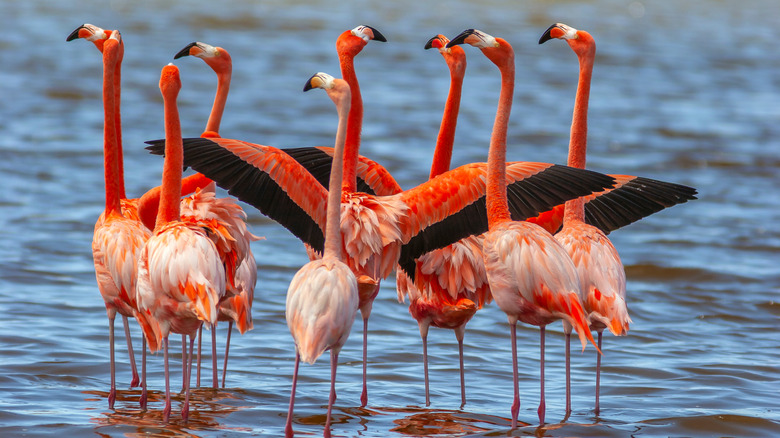The Bizarre Story Of Pink Floyd The Escaped Flamingo From Kansas
In 2003, 40 flamingos were transported from Tanzania to Wichita, Kansas. The flamingos were to be part of an exhibit at the Sedgwick County Zoo that would open the following year. To prevent flamingos from taking flight, the typical practice is to amputate a part of their wing after birth when the bones haven't formed and when they won't feel a thing. However, the flamingos that arrived were estimated to be at least 3 years old, and the zookeepers decided that it would be unethical to proceed with the practice at that age. Per the New York Times, zookeepers decided to keep them grounded by clipping their wings, which can be compared to humans having a haircut.
Two of the flamingos — tagged No. 492 and No. 347 — decided to escape the zoo in June 2005. Zoo personnel hadn't noticed that the flamingos needed to have their wings clipped, and the two were able to fly out of their enclosure. Several attempts were made to capture the flamingos, but they flew away whenever people would go near them. July came and by Independence Day, the flamingos were gone.
Flamingos' characteristics
It's a common misconception that flamingos are birds that can't fly. Those seen in zoos get their wings clipped preventing them from flying, but all species of flamingos are, indeed, capable of flying. In fact, they can fly at speeds of 35 mph, and can even reach up to 40 mph with help from strong winds. And they can travel long distances, too, as reported by the American Bird Conservancy. Furthermore, they can fly at a height of 20,000 feet, but they tend to fly at a lower altitude when above water.
Flamingos are known for their unique pink color, which is a result of their diet. These birds typically eat shrimps, algae, and crustaceans that are packed with the chemical beta carotene or carotenoids, which have yellow, orange, and red tints. Carotenoids are also found in carrots, papayas, tomatoes, and pumpkins (via New Scientist). When flamingos eat carotenoid-rich foods, their body absorbs the chemical, and the pigment is then transferred to the birds' skin and feathers. A flamingo's color depends on its diet, and it can have different shades of bright orange or vibrant pink to pale pink.
Where did the escaped flamingos go?
Flamingos No. 492 and No. 347 went their separate directions after escaping from the Kansas zoo. No. 347 headed north and was last spotted in AuTrain Lake in Michigan in 2005. No. 492 — also known as Pink Floyd — went to the south, particularly to Texas. Experts say that flamingos thrive in groups — a "flamboyance" as they are collectively called. In fact, as the New York Times reports, a flamingo in need of medical aid is kept in isolation with other flamingos for company.
Pink Floyd was spotted a few times throughout the years, once in 2006 and then again in 2013, and the bird was seen with a fellow flamingo of a different species. In 2018, Pink Floyd was again spotted but without a companion. March 2022 was the latest sighting of Pink Floyd, who was identified with the help of a No. 492 tag still attached to one leg. Per NPR, the Coastal Fisheries Division of the Texas Parks and Wildlife Department was able to capture a video of Pink Floyd in Cox Bay on Texas' Gulf Coast.
Pink Floyd will not be recaptured
It has been 17 years since Pink Floyd escaped from the Kansas zoo, and it looks like the bird is thriving. Flamingos have an average life span of 25 to 30 years when living in the wild, but when in captivity, they tend to live up to 40 years or so (via Flamingos World). Since the escape, Pink Floyd has been spotted in Texas and Louisiana occasionally.
According to The Washington Post, the Kansas zoo isn't interested in recapturing No. 492. The zoo's spokeswoman, Jennica King, said that they have accepted that Pink Floyd is destined to be in the wild. King also added that recapturing the bird might be detrimental not just for the flamingo, but for its current habitat as well. Pink Floyd's gender isn't known, as the bird wasn't tested before his escape, but zookeepers believe he is male. It is estimated that he is about 20 years old, and King said that they are happy that "he's living his best life down in Texas."



